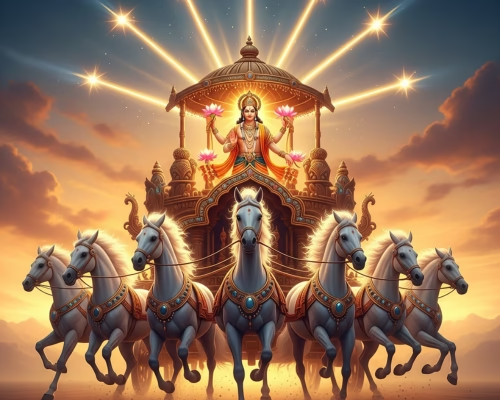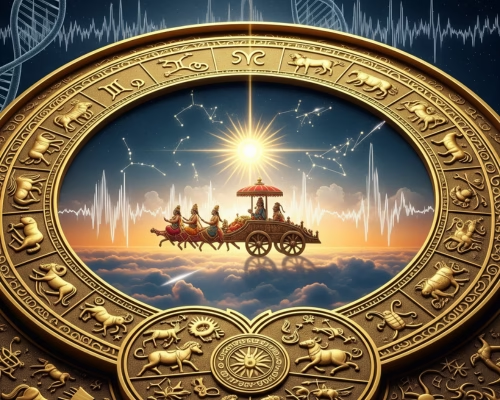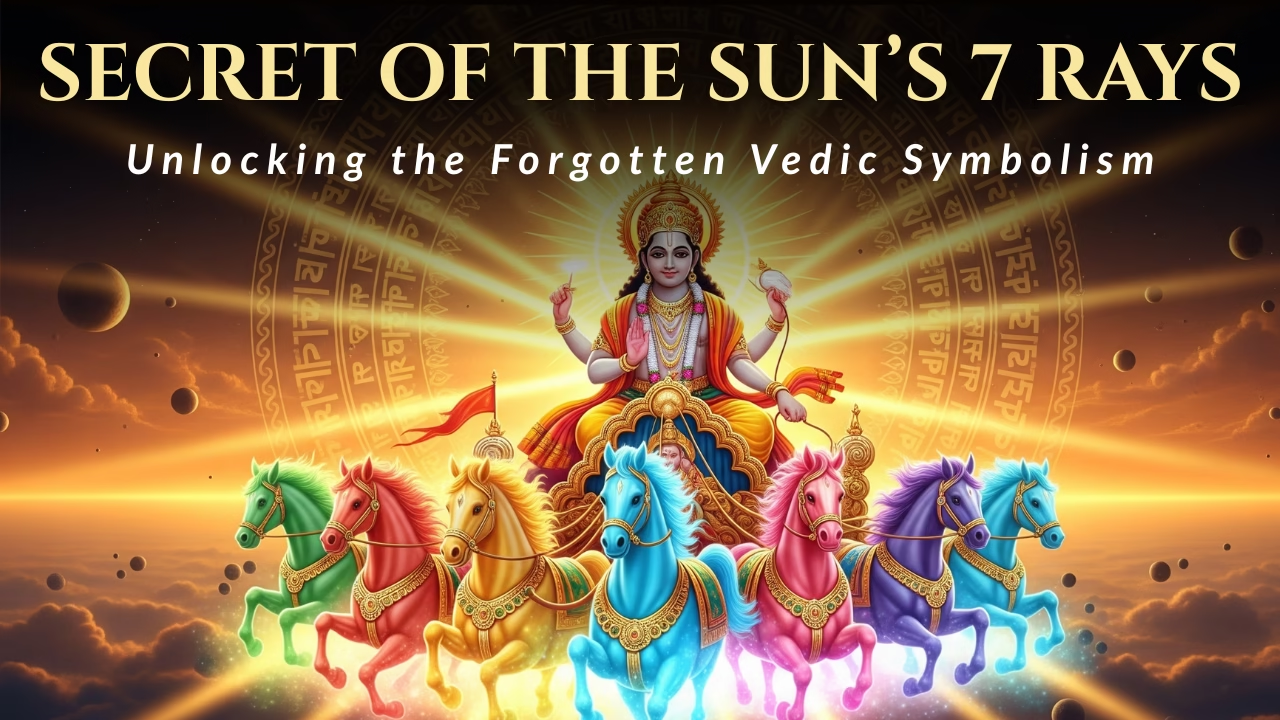You see the sun every day. But have you ever wondered — why does it shine the way it does?
In ancient India, the sun wasn’t just a celestial body. It was Surya, the divine source of time, energy, rhythm, and life. Across Vedic scriptures and temple art, there’s a curious pattern: the number seven — seven rays radiating from the sun and seven horses pulling Surya’s golden chariot.
But this isn’t mythology alone. It’s a coded message, deeply tied to nature, consciousness, and cosmic balance.
In the Rigveda, the sun is called Saptarashmi (सप्तरश्मि) — “the one with seven rays.”
Similarly, temple murals from Odisha to Tamil Nadu often depict seven white horses leading Surya’s chariot. This number isn’t random — it holds meaning across physics, spirituality, and cosmology.
What if the seven rays aren’t just about sunlight… but about life’s design itself?
Table of Contents
What Are the 7 Rays of the Sun?
In the sacred hymns of the Rigveda, the sun is honored not just as a physical light source, but as a conscious force of divine order. One of its names — Saptarashmi (सप्तरश्मि) — literally means “the one with seven rays.” These rays weren’t seen as mere beams of sunlight; they were believed to be channels of cosmic intelligence, each carrying a specific force into the world i.e. energy, rhythm, transformation, and life itself.
Unlike modern science, which describes light as a form of electromagnetic radiation, Vedic seers viewed light as a carrier of consciousness. They believed these seven rays reflected seven fundamental principles upon which creation rests. Some traditions associate them with willpower, wisdom, intelligence, harmony, discipline, devotion, and cosmic order. These concepts later echo in yogic teachings through the seven chakras, each responsible for a different level of spiritual growth and energy alignment.
The 7 Rays and Their Symbolic Meanings
| Ray No. | Vedic Name / Idea | Symbolism | Colour |
|---|---|---|---|
| 1️⃣ | Surya Tejas | Willpower, focus | Red |
| 2️⃣ | Jnana Shakti | Inner knowledge, intellect | Orange |
| 3️⃣ | Kriya Shakti | Action, transformation | Yellow |
| 4️⃣ | Samatva Shakti | Balance, harmony | Green |
| 5️⃣ | Shraddha | Faith, devotion | Blue |
| 6️⃣ | Dhyana Shakti | Intuition, meditative insight | Indigo |
| 7️⃣ | Moksha Jyoti | Liberation, cosmic unity | Violet |
Interestingly, the ancient idea of seven rays finds a parallel in modern optics. When white light passes through a prism, it splits into seven visible colors — VIBGYOR: violet, indigo, blue, green, yellow, orange, and red. Though Isaac Newton formally introduced this in the 17th century, the idea of light being composed of multiple energetic components was already embedded in Indian cosmology thousands of years ago. It makes you wonder—were the Vedas far ahead of their time, hinting at light’s deeper nature?
These rays also appear symbolically across other ancient systems. The seven sacred rivers of India, the seven days of the week, and the seven realms or lokas mentioned in Hindu cosmology all reinforce a repeating pattern: the number seven is more than numerical — it represents a complete cycle, a divine rhythm flowing through both the physical and spiritual worlds.
Far from being mythology, the seven rays of the sun reveal an ancient understanding of the multidimensional nature of existence — where the physical, metaphysical, and spiritual realms are deeply intertwined. And at the centre of it all is Surya, the sun — not just as a burning star, but as a symbol of the life force, the soul’s journey, and the harmony of the universe.
☀️ Why the Number 7 Repeats Across Indian Wisdom ☀️
The number 7 is no coincidence.
It appears in ancient Indian knowledge systems again and again:
7 rays of the sun (Rigveda: Saptarashmi)
7 colors in visible light (VIBGYOR)
7 chakras in the human body
7 days of the week (each ruled by a planetary deity)
7 sacred rivers in India
7 lokas (planes of existence in Hindu cosmology)
7 flames of the sacred Vedic fire (Agni)
In Vedic thought, 7 is not just a number—it’s a code of creation, rhythm, and consciousness.
The 7 Horses of Surya’s Chariot: Myth or Metaphor?
In Hindu iconography, Surya — the Sun God — is almost always shown riding a radiant chariot drawn by seven white horses. But what do these seven horses truly represent? Are they divine beings, symbolic energies, or just creative flourishes of ancient art?
The Rigveda refers to these horses as sapta ashvah, pulling the chariot across the sky. On the surface, it appears like a mythological motif. However, deeper interpretations suggest that these seven horses symbolize the seven colours of sunlight —the full spectrum of VIBGYOR — long before modern science named it so.
Just as a prism breaks white light into its colourful rays, Surya’s seven steeds represent the sunlight refracted into visible diversity, pulling time forward and life into motion. In this sense, the horses aren’t just animals — they are vehicles of cosmic energy.
Even the charioteer, Arun, is no random character. He is the red glow of dawn, the harbinger of light. His name means “reddish-brown” and he precedes Surya, like the first breath of morning before the sun rises.

The 7 Horses & Chakras – A Journey Within
What if Surya’s Chariot Was Inside You?
The seven horses of Surya’s chariot don’t just gallop across the sky — they may also gallop through your spine. According to many yogic traditions, the seven horses mirror the seven chakras, the energy centres of the human body.
Each chakra is said to vibrate at a particular frequency and radiate a specific colour — exactly like the seven colours of sunlight.
| Chakra | Color | Horse Parallel |
|---|---|---|
| Muladhara | Red | First Horse – Base Force |
| Svadhisthana | Orange | Second Horse – Creativity |
| Manipura | Yellow | Third Horse – Power |
| Anahata | Green | Fourth Horse – Love |
| Vishuddha | Blue | Fifth Horse – Voice |
| Ajna | Indigo | Sixth Horse – Vision |
| Sahasrara | Violet/White | Seventh Horse – Divinity |
In this metaphor, Surya becomes the conscious self or Atma, riding the horses (energies) up the path of spiritual evolution.
🐎 MYTH BUSTER BOX 🐎
Are There Really 7 Horses?
Did You Know?
Some depictions show just one horse with seven heads, not seven horses!
This reflects the non-duality of Vedic thought:
One horse = Unity of Light
Seven heads = Multiplicity of Rays (or Spectra)
So whether it’s seven horses or one multi-headed horse, the idea is the same:
From One Source, Many Energies Flow.
Surya’s Chariot & The Cosmic Clock
Light Is Time — And Surya Is Its Driver
In the Vedic worldview, Surya isn’t just a source of light — he’s the very keeper of time.
- His daily ride from East to West marks the rhythm of day and night.
- His annual journey through the 12 zodiac signs maps the passage of seasons.
- His cycles govern crop sowing, festivals, sleep, and even your hormonal cycles.
In essence, Surya’s chariot is the original timekeeping machine, and every wheel turn is a tick of the cosmic clock.
Kalachakra: The Wheel of Time
The Sanskrit word Kalachakra literally means “Wheel of Time.” It appears in:
- Rigveda, as the solar movement through samvatsara (a year).
- Astronomy, through Surya Siddhanta, detailing Earth’s orbit & eclipses.
- Spirituality, as cycles of yuga (epochs) and reincarnation.
Just like the chariot wheel rotates, so does time — cyclical, never linear.
Even today, Indian calendars (Panchangam) are solar-lunar hybrid clocks based on Surya’s chariot across zodiac houses — each month begins when Surya enters a new Rashi (zodiac).
🔍 MYTH BUSTER BOX 🔍
Ancient Indians believed the Sun was pulled by horses? Isn’t that primitive?
Not at all.
The ratha (chariot) is symbolic, not literal. Vedic rishis were keen astronomers — they tracked eclipses, planetary retrogrades, and solstices with astonishing precision.
The horse-drawn chariot represents celestial motion, not superstition.
Circadian Rhythms: Surya Inside Your Cells
Modern science confirms what yogis knew:
- Every cell in your body has a biological clock.
- Sunlight triggers melatonin, serotonin, and cortisol production.
- Disruption of solar exposure affects sleep, metabolism, and immunity.
You are literally tuned to Surya’s chariot.
Miss his light, and your body’s inner wheel spins out of sync.

The 7 Rays and Their Modern Symbolism
The concept of the seven rays isn’t just ancient philosophy locked away in Vedic texts — it’s a living symbol of how divine consciousness flows into our everyday reality. In Indian cosmology, each ray of the sun carries a unique spiritual quality — not just physical light, but an essence that awakens different aspects of our inner self.
- The first ray embodies pure will — it gives us the drive to act, lead, and create change.
- The second, often seen as the ray of love and wisdom, harmonizes our mind with compassion and dharma.
- The third ray sparks creativity and intelligent action — the energy of karma in motion.
- Then comes the fourth, a harmonizing force — the one that seeks beauty in balance and truth through contrast.
- The fifth ray reveals knowledge, clarity, and the pursuit of truth — seen in both science and spiritual inquiry.
- The sixth guides devotion and surrender, found in acts of bhakti, seva, and ritual.
- Finally, the seventh ray is the energy of transformation and structure — the one that binds the spiritual to the material, seen in yoga, temple rituals, and even habits we form.
🔍 MYTH BUSTER BOX 🔍
Do All Cultures Recognize 7 Rays?
Yes — and here’s the surprise.
Ancient Egypt’s Aten, Christianity’s Seven Spirits of God (Revelation), the Buddhist Vajrayana light rays, and even esoteric Theosophy all speak of sevenfold divine light.
But Bharat goes deeper — giving each ray a role in the cosmic play of life, death, rebirth, and liberation.
The 7 Horses of Surya: Cosmic Code Hidden in Plain Sight
From every ancient sun temple to school textbooks, we’ve all seen it — Surya, the Sun God, riding a golden chariot pulled by seven white horses.
But very few ask:
Why horses? Why seven? What’s the hidden truth?
In Vedic symbolism, horses are not just majestic animals — they’re embodiments of energy, time, and rhythm. Each of the 7 horses represents one day of the week, reminding us that time itself is pulled forward by the power of the Sun.
The horses aren’t literal. They symbolize the 7 meters (Chhandas) of Vedic poetry — Gayatri, Ushnik, Anushtubh, Brihati, Pankti, Trishtubh, and Jagati — each governing a cosmic vibration or rhythm of creation.
Source: Rigveda 1.164.24 – “With seven reins he yoked the seven horses to the one-wheeled chariot of the sun.”
Interestingly, the Sun’s chariot has only one wheel — representing oneness of time, while the 7 horses denote its division into manageable rhythm and cycles. This was the Vedic way of encoding both unity and diversity — one source of energy, expressed in seven forms.
Beyond the Horses — The Secret of Time, Light & Consciousness
We’ve traced the 7 horses of the Sun across verses, meters, days, and philosophies. But here’s the deeper revelation:
The 7 horses are not animals — they are laws of light and time.
In Vedic cosmology, the Sun is not just a fireball — it is the master of Kaal (Time). With each dawn, it sets the rhythm of existence — day, night, seasons, aging, even rebirth. Time flows because the Sun moves.
So what do the 7 horses truly symbolize?
They represent the 7 phases of time that structure both the universe and your life:
- Dawn — emergence of thought
- Morning — action and clarity
- Noon — peak energy, expansion
- Afternoon — reflection
- Dusk — withdrawal and letting go
- Evening — stillness, receptivity
- Night — return to source, the unknown
Just like the horses that pull the Sun’s chariot across the sky, these 7 phases pull your awareness through the cycle of a day — and metaphorically, through the cycle of a lifetime.
Why It Matters:
- The Sun doesn’t just rise and set outside you — it rises and sets within your thoughts, moods, and energies.
- Recognizing this rhythm is the key to living in sync with the cosmos.
- Ancient Indians didn’t worship the Sun out of fear — they did so with awe, because they saw it as the very rhythm of intelligence.
When the Vedas speak of “7 horses, but no reins,” they’re hinting that this cosmic rhythm isn’t controlled — it flows freely, like pure consciousness.
And you, dear reader, are not separate from it.
Conclusion: The 7 Horses Were Never Just Horses
You came here asking, “Why does the Sun have 7 horses?”
But now you know — the question was never about animals.
It was about you. About time, energy, and the light that powers your life.
Ancient seers encoded the mysteries of reality into symbols — and the 7 horses are among the most powerful.
They stand not just for movement, but for the invisible forces that move you:
Your thoughts.
Your habits.
Your cycles.
Your inner Sun.
Whether you see them as Vedic meters, spectrums of light, or steps of consciousness — one truth shines through:
You are the charioteer now.
The Sun rises every morning — not to blind you with light, but to remind you of your own.
Don’t just read the Vedas.
See them.
Live them.
Become them.
Read more at – Whispers Of Bharat
FAQs – Frequently Asked Questions
1. What do the 7 horses of the Sun God represent in Hinduism?
The 7 horses represent the seven rays of the sun, symbolizing the seven colours of light, seven days of the week, and seven levels of spiritual consciousness. This isn’t just mythology — it’s a coded spiritual metaphor reflecting cosmic order.
2. Are the 7 sun rays the same as the colours in the rainbow?
Yes, in many interpretations, the 7 rays correspond to the VIBGYOR spectrum—but in Vedic thought, they go deeper. Each ray is also tied to a chakra, a cosmic function, or a deity energy, making it both physical and spiritual.
3. Is this symbolism backed by ancient Vedic texts?
Absolutely. While explicit mention of “7 rays” might not always appear in a modern phrasing, scriptures like the Rigveda, Surya Upanishad, and Valmiki Ramayana refer to the Sun’s chariot with 7 horses, each with profound metaphysical meaning.
4. How are the 7 rays related to meditation or chakra practices?
Each ray aligns with one of the seven chakras, forming a light-energy blueprint within the human body. Meditating on each ray can help awaken the chakras, restore balance, and elevate consciousness in traditional yogic practice.
5. Is the number 7 just symbolic or scientific?
It’s both. Scientifically, sunlight refracts into 7 colors. Spiritually, the number 7 recurs in cosmic rhythms, like 7 heavens, 7 sages (Saptarishis), and 7 musical notes. The number bridges cosmos, consciousness, and culture.
6. Why only 7 rays? Why not more or less?
Vedic seers weren’t arbitrarily poetic. The number 7 reflects natural divisions of time, energy, and light. It’s not random; it encodes a pattern present in creation itself. That’s why even other traditions (like Christianity, Zoroastrianism, and Theosophy) reference the 7 rays.



